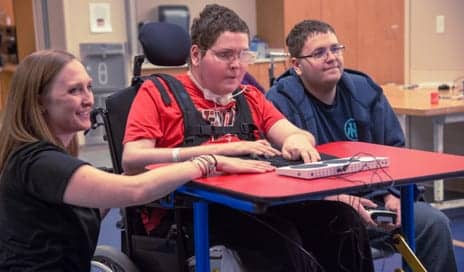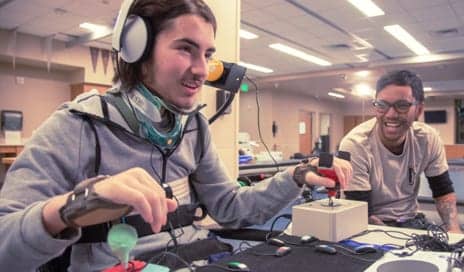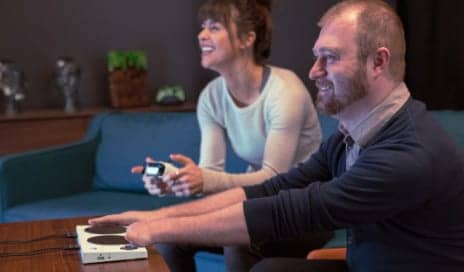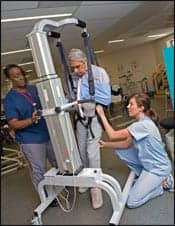The strength of adaptive technology has rippled out into the video gaming realm. On May 16 Microsoft reported the coming release of the Microsoft Xbox Adaptive Controller, which allows individuals who have extremely limited function in their upper extremities to take the controls of their favorite video game. For people affected by spinal cord injury, cerebral palsy, traumatic brain injury, or other challenging physical circumstances, the Microsoft Xbox Adaptive Controller brings individuals into the game who previously watched from the sidelines.
While Microsoft has stocked the gaming market with a variety of controllers lauded for their customization ability, comfort, and responsiveness, those devices uniformly share one shortcoming: their designers assume the user will have two hands.
“The latest controller for Xbox totally changes this script,” tech industry reporter, Jessica Conditt, says in a report about the new device. “It’s built for players with one hand, no hands, or lack of fine motor control.”

Erin Muston-Firsch, MSOT, looks on as Corey uses features built into the new adaptive controller to play video games with his twin brother, Zachary.
In contrast to the popular butterfly shape of conventional Xbox controllers, the adaptive controller is an 11-inch by 6-inch rectangle, loaded with 19 inputs on the back that correspond with every button on a conventional Xbox controller. Microsoft reports that the device can be connected to external switches, buttons, mounts, and joysticks. Accessories include a sip-puff joystick, a one-handed joystick, and hardware that allows the game to be controlled with one leg placed between two buttons.
An online video depicts how individuals affected by varying disabilities are using the adaptive controller.
Therapeutic Dimensions
For occupational therapists and physical therapists, the new adaptive controller may represent a device that not only has therapeutic qualities to be harnessed, but a way to reconnect patients recovering from injury with their favorite pastimes, and maintain personal relationships.
“Our role as occupational therapists is to get people back to doing,” says Erin Muston-Firsch, MSOT, a clinician at Craig Hospital, Denver, in a video that demonstrates how the controller is used by patients who have spinal cord injuries. The device is made to integrate smoothly and provide a user experience that will be familiar to experienced gamers.
For those who want to get back to gaming rather than be faced with a litany of technical glitches, Muston-Firsch says of the new controller, “It just works.”

Jonah, a young video gamer, says the larger joysticks and larger buttons engineered into the new adaptive controller make it easier for him to operate the gaming platform. Mike Luckett, at right, is a retired U.S. Army captain, who helped test the controller.
The device can also positively affect socialization, according to Muston-Firsch. In the video she explains that prior to a spinal cord injury a favorite pastime of a young male patient at Craig was to play video games regularly with his twin brother. The interaction provided a way for them to relate to each other prior to the injury. Muston-Firsch points out that the new controller’s “co-pilot” feature enabled the brothers to once again play video games with each other.
Engineers and Disabled Gamers Collaborate
The inspiration for the controller took root in 2014 when a Microsoft employee reportedly stumbled onto a Twitter photo that depicted a video game controller developed for injured war veterans. To participate in video games some veterans had to overcome obstacles created by multiple amputations, quadriplegia, and traumatic brain injury.
A collaboration of purposeful hacking followed, which helped fuel teamwork inside Microsoft’s Inclusive Tech Lab between the company’s hardware developers and gamers affected by disabilities who were brought into the lab for consultation.

Solomon Romney, who was born without fingers on his left hand, says the new adaptive controller is simple to use, and can be customized to how the user wants to interface with the device at any time.
“As the game platforms have gotten more sophisticated, the controllers have gotten more sophisticated, and [playing the games] started to get frustrating,” says a gamer identified only as ‘John,’ who is affected by cerebral palsy on his entire right side. He explains in an online video the how the interface allows him to engage in play.
Microsoft chief accessibility officer, Jenny Lay-Flurrie, notes in her May 16 blog entry that the device is designed primarily for gamers who have limited mobility. Furthermore, she says, the device will allow individuals to create a custom controller experience that is affordable, and will be adaptive to a variety of disabilities.
Lay-Flurrie writes: “We gained feedback from people with disabilities and collaborated with gamers to build an accessible controller from the ground up, and I think this will make a huge difference for gamers of all abilities — connecting more gamers than ever before.”
Individuals can request an email notification from Microsoft when the controller becomes available.
Frank Long is editorial director of Rehab Management and Physical Therapy Products. For more information, contact [email protected].




